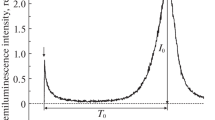Abstract
The effect of eugenol on xanthine oxidase (XO) xanthine(X)-Fe+3-ADP mediated lipid peroxidation was studied in liver microsomal lipid liposomes. Eugenol inhibited the lipid peroxidation in a dose dependent manner as assessed by formation of thiobarbituric acid reactive substances. When tested for its effect on XO activity per se, (by measuring uric acid formation) eugenol inhibited the enzyme to an extent of 85% at 10 µm concentration and hence formation of O2 also However, the concentration of eugenol required for XO inhibition was more in presence of metal chelators such as EDTA, EGTA and DETAPAC, but not in presence of deferoxamine, ADP and citrate. The antiperoxidative effect of eugenol was about 35 times more and inhibition of XO was about 5 times higher as compared to the effect of allopurinol. Eugenol did not scavenge O2 generated by phenazine methosulfate and NAD but inhibited propagation of peroxidation catalyzed by Fe2+ EDTA and lipid hydroperoxide containing liposomes. Eugenol inhibits XO-X-Fe+3 ADP mediated peroxidation by inhibiting the XO activity per se in addition to quenching various radical species. (Mol Cell Biochem 166: 65-71, 1997)
Similar content being viewed by others
References
IARC Monographs: Evaluation of caromogenic risk of chemicals to humans, Lyon, France 36: 75–97, 1985
Paffenbarqer GC: Rupp NW: Dental Materials. In: M. Grayson (eds). Kirk-Othmer Encyclopedia of Chemical Technology. John Wiley and sons, New York, 1979 vol. 7, pp 463–464, 498–499
FAO/WHO Expert Committee on Food Additives: Evaluation of certain food additives and contaminants, WHO Technical Report Series 683. 20, 1982
Opdyke DLJ: Monographs on fragrance and raw materials: Eugenol. Fd Cosmet Toxicol 13: 545–547, 1975
McCord JM: Oxygen-derived free radicals in postischemic tissue injury. N Engl J Med 312: 159–163, 1985
Friedl HP, Till GO, Trentz O, Ward PA: Roles, of histamine complement and xanthine oxidase in thermal injury of skin. Am J Path 135: 203–217, 1989
Grum CM, Ragsdale RA, Ketai LH, Simon RH: Plasma xanthine oxidase activity in patients with adult respiratory distress syndrome. J Crit Care 2: 22–26, 1987
Oda T, Akaike T, Hamamoto T, Suzuki F, Hirano T, Maeda H: Oxygen radicals in influenza-induced pathogenesis and treatment with pyran polymer-conjugated SOD. Science 244: 974–976, 1989
Tan S, Yokoyama Y, Dickens E, Cash TG, Freeman BA, Parks DA: Xanthine oxidase activity in the circulation of rats following hemorrhagic shock. Free Rad Biol Med 15: 407–414, 1993
Halliwell B, Aeschbach R, Loliger J, Aruoma OI: The characterization of antioxidants. Fd. Chem Toxic 33: 601–617, 1995
Cohen MV: Free radicals in ischemic and reperfusion myocardial injury. Is this the time for clinical trials?. Ann Intern Med 111: 918–931, 1989
Nagababu E, Lakshmaiah N: Inhibitory effect of eugenol on nonenzymatic lipid peroxidation in rat liver mitochondria. Biochem Pharmacol 43: 2393–2400, 1992
Nagababu E, Lakshmaiah N: Inhibition of microsomal lipid peroxidation and monooxygenase activities by eugenol. Free Rad Res 20: 253–266, 1994
Nagababu E, Sesikeran B, Lakshmaiah N: The Protective effects of eugenol on carbon tetrachloride induced hepatotoxicity in rats. Free Rad Res 23: 617–627, 1995
Rajakumar DV, Rao MNA: Dehydrozingerone and isoeugenol as inhibitors of lipid peroxidation and as free radical scavengers. Biochem Pharmacol 46: 2067–2072, 1993
Jeng JH, Hahn LJ, Lu FJ, Wang YJ, Kuo MYP: Eugenol triggers different pathobiological effects on human oral mucosal fibroblasts. J Dent Res 73: 1050–1055, 1994
Tsuzimoto Y, Hashizume H, Yamazaki M: Superoxide radical scavenging activity of phenolic compounds. Int J Biochem 25: 491–494, 1993
Krishnakantha TP, Lokesh BR: Scavenging of superoxide anions by spice active principles. Indian J Biochem Biophys 30: 133–134, 1993
Ernster L, Nordenbrand K: Microsomal lipid peroxidation. Meth Enzymol 10: 574–580, 1967
Bligh EG, Dyer WJ: A rapid method of total lipid extraction and purification. Can J Biochem Physiol 37: 911–917, 1959
Marinetti GV: Chromatographic separation, identification and analysis of phosphotides. J Lipid Res 3: 1–20, 1962
Okhawa H, Ohishi N, Yagi K: Reaction of linoleic acid hydroperoxide with thiobarbituric acid. J Lipid Res 19: 1053–1057, 1978
Janero DR, Lopez R, Pittman J, Burghardt B: Propranolol as xanthine oxidase inhibitor. Implications for antioxidant activity. Life Sci 44: 1579–1588, 1989
Nishikimi M, Appaji Rao N, Yagi K: The occurrance of superoxide anion in the reaction of reduced phenazine methosulfate and molecular oxygen. Biochem Biophys Res Communs 46: 849–854, 1972
Gutteridge JMC. Ferrous ion-EDTA-stimulated phospholipid peroxidation. A reaction changing from alkoxyl radical to hydroxyl radical dependent initiation. Biochem J 224: 697–701, 1984
Robak J and Gryglowski RJ. Flavonoids are scavengers of Superoxide anions. Biochem Pharmacol 37: 837–841, 1988
Roussos GG, Xanthine Oxidase from bovine small Intestine. Meth Enzymol 12: 5–16, 1967
Kronmon MJ, Bratcher SC: An expermental artifact in the use of chelating metal ion buffers. Binding of chelators to bovine α-lactalbumin. J Biol Chem 258: 5707–5709, 1983
Shina R, Yates SL, Ghassemi A, Rosenberg P, Condrea E: Inhibitory effect of EDTA-Ca2+ on the hydrolysis of synaptosomal phospholipids by phospholipase A2 toxins and enzymes. Biochem Pharmacol 40: 223–2239, 1990
Banerjee RK: EDTA inhibits peroxidase catalyzed iodide oxidation through interaction at the iodide binding site. Biochem Biophys Acta 992: 393–396, 1989
Author information
Authors and Affiliations
Rights and permissions
About this article
Cite this article
Nagababu, E., Lakshmaiah, N. Inhibition of xanthine oxidase — xanthine — iron mediated lipid peroxidation by eugenol in liposomes. Mol Cell Biochem 166, 65–71 (1997). https://doi.org/10.1023/A:1006878315029
Issue Date:
DOI: https://doi.org/10.1023/A:1006878315029




